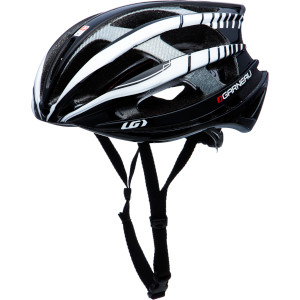ChainLove
Gear Merchant
Louis Garneau Quartz II Helmet

Basic logic tells us that more ventilation equates to less materials, meaning that a well ventilated helmet should, in theory, be lightweight. However, comparing the the Louis Garneau Diamond II to the Quartz II turns this logic on its head. You see, while the Diamond II has the most ventilation ports of any helmet on the market, 40 in total, it comes in 35 grams heavier than the 33-vent, 285 gram Quartz II. Surely, some engineering wizardry is at work.
So, how did Garneau do it? Essentially, it was accomplished through its patented Super MSB (Monocoque Structural Base) and a careful material selection. Basically, these two components work in unison to eliminate the commonality of rib construction in helmets. As Garneau puts it, the prior means of manufacturing adds weight and minimizes the amount of potential ventilation, all the while without increasing safety. And while all of that sounds pointless and archaic, the solution was complicated from engineering standpoint.
The path to the Quartz II took a few steps. The Super MSB structure is basically a supportive base that's akin to an exoskeleton. It has a polycarbonate, monocoque construction, meaning that it's formed in one piece. This reinforces the perimeter of the helmet, while supporting the carbon composite skeleton reinforcement with confidence -- and this is where the rib-replacement comes into play. Together, the two systems position two polycarbonate bars within the helmet structure, with an additional nine carbon fiber bridge inserts. The system provides targeted structural support to the helmet in the case of collision. For further reinforcement, the entire structure is created with In-Mold construction. This means that the helmet's shell and foam liner are molded together at the same time.
With Garneau's new structural design, it was able to increase the ventilation without degrading strength. But Garneau wasn't finished with the Quartz II's comfort. The helmet features what Garneau calls its Evacuation Channels. These ports in the helmet provide an increased airflow over the head, while creating a dispersion of internal moisture. To secure the helmet, Garneau incorporated its Spiderlock PRO II stabilizing system that permits one-handed adjustments to the helmet's retention. It also has a polymer neck support and an anti-slip turn-wheel for precise and secure adjustment. At the chinstrap, the Diamond II comes equipped with cam-locking device that simplifies the process of dialing-in the helmet's fit. And lastly, Garneau also included X-static XT2 padding internally for its antimicrobial, comforting support.
For a touch of added safety in low-light conditions, the helmet also comes equipped with Garneau's Spiderlock Vision Light that mounts to the turn buckle of the Spiderlock.
The Louis Garneau Quartz II Helmet is available in four sizes from Small to X-Large and in the colors Black, Matte Black, Red, and White Customizable.
Price: $64.99 (56% Off!)
Regularly: $149.95
Buy Now

Basic logic tells us that more ventilation equates to less materials, meaning that a well ventilated helmet should, in theory, be lightweight. However, comparing the the Louis Garneau Diamond II to the Quartz II turns this logic on its head. You see, while the Diamond II has the most ventilation ports of any helmet on the market, 40 in total, it comes in 35 grams heavier than the 33-vent, 285 gram Quartz II. Surely, some engineering wizardry is at work.
So, how did Garneau do it? Essentially, it was accomplished through its patented Super MSB (Monocoque Structural Base) and a careful material selection. Basically, these two components work in unison to eliminate the commonality of rib construction in helmets. As Garneau puts it, the prior means of manufacturing adds weight and minimizes the amount of potential ventilation, all the while without increasing safety. And while all of that sounds pointless and archaic, the solution was complicated from engineering standpoint.
The path to the Quartz II took a few steps. The Super MSB structure is basically a supportive base that's akin to an exoskeleton. It has a polycarbonate, monocoque construction, meaning that it's formed in one piece. This reinforces the perimeter of the helmet, while supporting the carbon composite skeleton reinforcement with confidence -- and this is where the rib-replacement comes into play. Together, the two systems position two polycarbonate bars within the helmet structure, with an additional nine carbon fiber bridge inserts. The system provides targeted structural support to the helmet in the case of collision. For further reinforcement, the entire structure is created with In-Mold construction. This means that the helmet's shell and foam liner are molded together at the same time.
With Garneau's new structural design, it was able to increase the ventilation without degrading strength. But Garneau wasn't finished with the Quartz II's comfort. The helmet features what Garneau calls its Evacuation Channels. These ports in the helmet provide an increased airflow over the head, while creating a dispersion of internal moisture. To secure the helmet, Garneau incorporated its Spiderlock PRO II stabilizing system that permits one-handed adjustments to the helmet's retention. It also has a polymer neck support and an anti-slip turn-wheel for precise and secure adjustment. At the chinstrap, the Diamond II comes equipped with cam-locking device that simplifies the process of dialing-in the helmet's fit. And lastly, Garneau also included X-static XT2 padding internally for its antimicrobial, comforting support.
For a touch of added safety in low-light conditions, the helmet also comes equipped with Garneau's Spiderlock Vision Light that mounts to the turn buckle of the Spiderlock.
The Louis Garneau Quartz II Helmet is available in four sizes from Small to X-Large and in the colors Black, Matte Black, Red, and White Customizable.
Price: $64.99 (56% Off!)
Regularly: $149.95
Buy Now